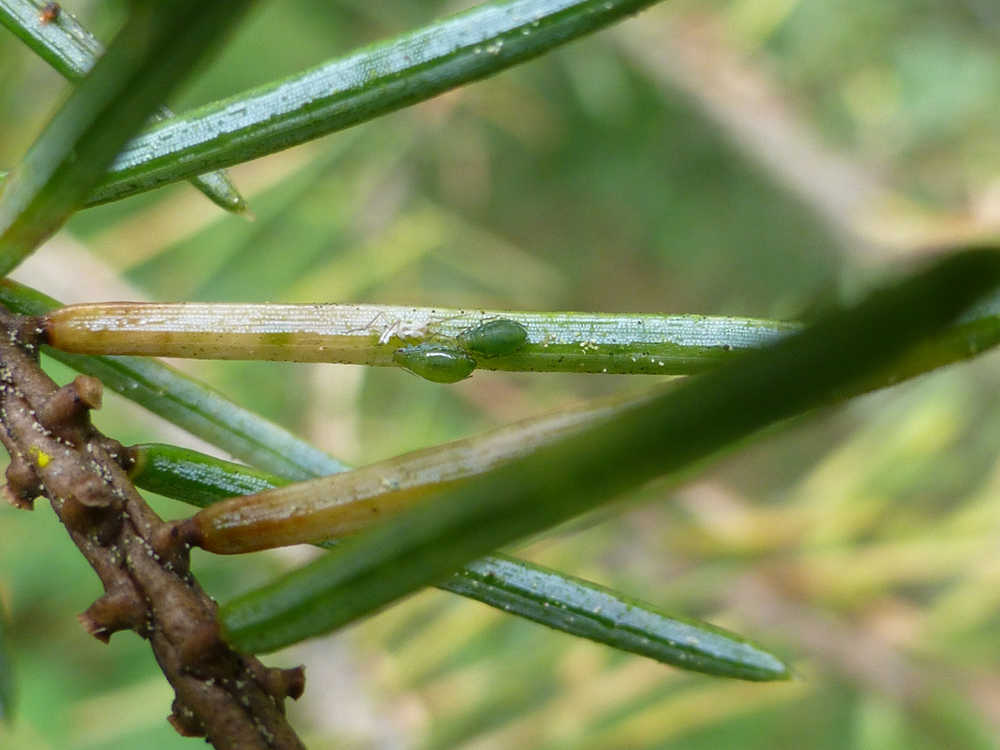When the needles began to fall like rain earlier in the summer, and piled up in windrows on sidewalks and roadways, every one wondered why that was happening. Spruce needles only last a few years, so if there had been a really good growth of new needles a few years ago, they would be ready to fall off about now. However, that was not the explanation, as we now know.
The perpetrator is the spruce aphid (Elatobium abietinum), an invasive species from Europe. In Europe, this aphid fed on Norway spruce, but apparently did not emerge as a serious pest until Sitka spruce was introduced and grown commonly in plantations, especially in the United Kingdom, where it has been studied intensively. There, the crowded plantation conditions, mild climate and lack of natural enemies allowed the aphid to have a field day.
How this species got to North America is not clear, but it is now present in most spruce forests on our continent. In some places, and under some conditions, the aphid can wreak havoc in spruce forests, but here in Southeast, the major effects of its foraging are seen near the coast and in towns. In many places, low winter and spring temperatures can kill off most of the aphids and keep the aphid population at low levels, but our warm maritime climate and the warmer temperatures in towns allow the population to build up. That is especially true when we don’t have a real winter or late spring frosts, as happened here last winter and spring.
Beginning in spring, these aphids feed on old needles, not the new growth of the present year. Why would it concentrate on tough old needles and avoid the tender new growth? After the first flush of needle growth, the new needles are reported to have lower amounts of certain essential amino acids, on average, than older needles. Those amino acids are critical for building proteins and for reproduction.
Aphid feeding reportedly does not induce the production of defensive compounds but may, in fact, even improve the quality of the foliage for the next generation. And why do the aphids stop feeding during the summer and fall, even though temperatures are favorable for them? Perhaps because the nutritional value of the needles has changed with the season.
This aphid has an interesting variation in its life cycle. In Europe, where it is native, it can reproduce sexually, with males and females, or asexually, via parthenogenesis (virgin birth), with no males involved. Here in North American, males have seldom been found, and all populations are composed solely of females that reproduce asexually. The parthenogenetic females produce all female babies, and they do it by skipping the egg stage and giving birth directly to live young. So females make more females, which in turn make more females, without taking time for eggs to develop, and this permits a rather rapid population increase.
A serious infestation of the aphid and the resulting loss of needles can reduce the growth of the affected trees and sometimes interfere with cone production. In addition, it can disrupt bud formation and therefore diminish the amount of new foliage the following year. On the other hand, fallen needles decompose and probably fertilize future growth of the trees, compensating at least in part for the initial effects of needle loss, as has been reported for other systems.
There have been periodic outbreaks in Southeast for decades (see the article by Kevin Gullufsen in the Empire on June 24), with no apparent permanent effects on our forest. However, warming climate trends may allow repeated aphid outbreaks, which could cause cumulative effects over time. In addition, sometimes trees that are damaged by beetles or mistletoe or other enemies may be particularly susceptible to aphid damage: injury upon injury.
Researchers think that most of the closed-canopy, continuous conifer forest in Southeast will not suffer extensive damage from the current aphid outbreak. They will be on the lookout for repeated infestations and possible cumulative effects. Although the population effects of aphid infestations are presently concentrated near the coast and in towns, the population is expanding its range, moving northward (to the Kenai Peninsula, for example) and up the mountain slopes. There are genetic differences among individual spruces in the effectiveness of resistance to aphids, but it remains to be seen if that affects the patterns of infestation in Southeast. It’s an on-going research project.
Author’s note: Thanks to Drs. Elizabeth Graham and Paul Hennon (Forestry Sciences Lab) for useful instruction.
• Mary F. Willson is a retired professor of ecology.

